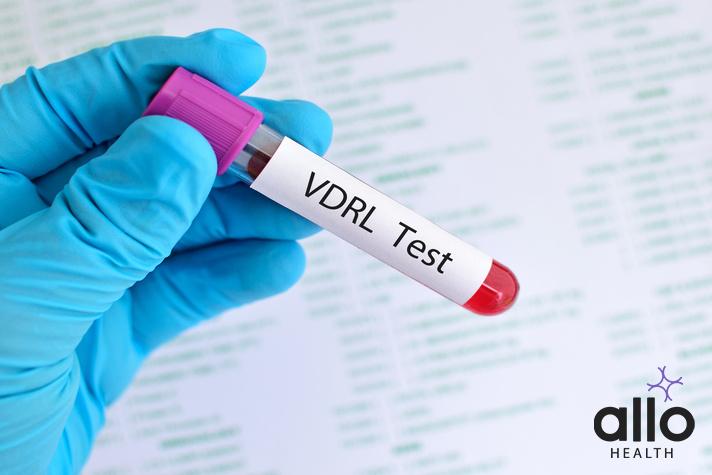Can We Take VDRL Test for HIV Diagnosis?

Allo Health is dedicated to personalized well-being, offering support and trusted information tailored to individual health goals. The platform emphasizes human-generated content, led by a distinguished medical team of experts, including physicians and sexual health specialists. Their commitment to credibility involves rigorous fact-checking, authoritative research, and continuous updates to ensure accurate, up-to-date information. Allo Health's unique approach goes beyond conventional platforms, providing expert-led insights and a continuous commitment to excellence, with user feedback playing a crucial role in shaping the platform's authoritative voice.

Dr Sanina Mansoor holds MBBS degree from Yenepoya university,Mangalore.She has 8 years of experience working as a medical officer at various health centres and medical colleges.
Why This Was Upated?
Our experts continually monitor the health and wellness space, and we update our articles when new information became available.
Updated on 15 March, 2024
- Article was updated as part of our commitment to diversity, equity, and inclusion.

"The following blog article provides general information and insights on various topics. However, it is important to note that the information presented is not intended as professional advice in any specific field or area. The content of this blog is for general educational and informational purposes only.
Book consultation
The content should not be interpreted as endorsement, recommendation, or guarantee of any product, service, or information mentioned. Readers are solely responsible for the decisions and actions they take based on the information provided in this blog. It is essential to exercise individual judgment, critical thinking, and personal responsibility when applying or implementing any information or suggestions discussed in the blog."
The VDRL test, short for Venereal Disease Research Laboratory test, is a crucial diagnostic tool used to detect the presence of syphilis antibodies in the blood. Despite its name, the VDRL test is not specific to HIV but is primarily employed in the diagnosis of syphilis, a sexually transmitted infection caused by the bacterium Treponema pallidum. This article delves into the intricacies of the VDRL test, its significance in diagnosing syphilis, and the broader implications for healthcare.
What is VDRL Test?
The VDRL test, or venereal disease research laboratory test, is a diagnostic tool primarily utilized in detecting syphilis antibodies in blood samples. It operates by identifying antibodies produced by the body in response to Treponema pallidum, the bacterium causing syphilis.
- Screening Tool: The VDRL test screens for the presence of syphilis antibodies.
- Sample Collection: A healthcare provider collects a blood sample through venipuncture.
- Antibody Detection: It detects antibodies formed against the syphilis-causing bacteria.
- Stages of Syphilis: While it becomes more reliable in later stages, false negatives can occur in early infections.
- Interpretation: False-positive results are possible and require confirmatory testing.
- Cost and Availability: Prices may vary, and additional tests might be necessary for a comprehensive diagnosis, depending on the healthcare provider and location.
Can VDRL Test Helps with HIV Diagnosis?
- No, the VDRL test is not specifically designed to diagnose HIV. The VDRL test is primarily used to detect the presence of syphilis antibodies in the blood, aiding in the diagnosis of syphilis infection caused by the Treponema pallidum bacterium.
- While both syphilis and HIV are sexually transmitted infections (STIs), they are caused by different pathogens and require distinct diagnostic approaches.
- However, individuals engaging in high-risk sexual activities should undergo comprehensive STI screenings, including tests for both syphilis and HIV, to ensure early detection and appropriate medical intervention. Timely treatment is crucial for managing these infections and preventing further transmission.
- Healthcare providers may recommend additional tests, such as Treponemal tests for syphilis and HIV antigen/antibody tests for HIV, to accurately diagnose and manage these STIs effectively.
How Does VDRL Test Works?
The VDRL test is not specifically designed to diagnose HIV; rather, it primarily detects syphilis antibodies in the blood. However, individuals infected with HIV are at an increased risk of contracting other sexually transmitted infections, including syphilis. In such cases, the VDRL test can indirectly indicate the presence of HIV by identifying syphilis infection, as both diseases may coexist due to similar modes of transmission, such as unprotected sexual activities.
- Screening for Co-Infections: Healthcare providers often recommend the VDRL test for individuals undergoing HIV testing, especially those engaging in high-risk sexual activities, to screen for potential co-infections such as syphilis.
- Risk Assessment: A positive VDRL test result may prompt further evaluation for HIV infection, considering the increased susceptibility of individuals with syphilis to other sexually transmitted diseases, including HIV.
- Comprehensive Health Assessment: The VDRL test forms part of a comprehensive health assessment for individuals at risk for syphilis and HIV, enabling healthcare professionals to provide appropriate care and counseling regarding safer sexual practices and the importance of regular screenings.
- Diagnostic Implications: While the VDRL test itself does not directly diagnose HIV, its results can inform healthcare providers about the individual’s overall risk profile and the need for additional testing or interventions to address potential co-infections and associated health risks.
Overall, while the VDRL test primarily targets syphilis diagnosis, its role in identifying co-infections such as HIV underscores its importance in comprehensive healthcare management for individuals engaging in high-risk sexual activities.
Benefits of VDRL Test

The VDRL test, while primarily used for detecting syphilis, can also offer indirect benefits in HIV diagnosis, particularly in high-risk populations. Here are some key advantages:
- Screening for Co-Infections: Individuals engaging in high-risk sexual activities are often susceptible to multiple sexually transmitted infections (STIs), including both syphilis and HIV. The VDRL test serves as a convenient screening tool to detect syphilis antibodies, prompting healthcare providers to also consider HIV testing, especially in cases where there is a history of unprotected sexual contact or intravenous drug use.
- Early Detection: Since syphilis and HIV share similar modes of transmission, the presence of syphilis may indicate heightened risk factors for HIV acquisition. Detecting syphilis through the VDRL test can prompt timely HIV testing and subsequent initiation of treatment, if necessary, thus improving overall health outcomes for the individual.
- Increased Awareness: A positive VDRL test result can serve as a catalyst for individuals to become more aware of their sexual health status. This heightened awareness may encourage them to engage in safer sexual practices and seek regular healthcare check-ups, reducing the risk of further STI transmission and promoting overall wellbeing.
- Opportunities for Comprehensive Care: Diagnosis of both syphilis and HIV allows healthcare providers to offer comprehensive care, including appropriate treatment regimens and counseling services tailored to address the specific needs of individuals at risk for multiple STIs.
While the VDRL test itself does not directly diagnose HIV, its role in detecting syphilis can indirectly lead to earlier HIV diagnosis, increased awareness of sexual health, and opportunities for comprehensive care, ultimately contributing to improved health outcomes in high-risk populations.
Stages of Syphilis and VDRL Test

The relationship between the stages of syphilis and the VDRL test is integral to understanding the effectiveness of the test in diagnosing the infection. Here’s how they correlate:
- Primary Syphilis: During the primary stage, which typically occurs within a few weeks of infection, a sore known as a chancre may appear at the site of contact with the syphilis-causing bacteria. At this stage, the VDRL test may yield false-negative results due to the body’s initial immune response, which may not have produced sufficient antibodies for detection.
- Secondary Syphilis: In the secondary stage, which can manifest weeks to months after the appearance of the chancre, symptoms such as skin rash, sore throat, and fever may occur. The VDRL test becomes more reliable in this stage as the body produces a higher concentration of antibodies in response to the infection, increasing the likelihood of detection.
- Latent and Late Stages: During the latent and late stages of syphilis, the VDRL test remains effective in detecting the presence of syphilis antibodies, aiding in the diagnosis and monitoring of the infection. However, false positives can occur, necessitating confirmatory testing to ensure accurate diagnosis and appropriate treatment.
Understanding the relationship between the stages of syphilis and the VDRL test is crucial for healthcare providers to interpret test results accurately and provide timely treatment to individuals at risk for syphilis infection.
Interpreting VDRL Test Results for HIV
Interpreting VDRL test results for HIV involves understanding the stages of syphilis infection and the significance of antibody detection:
- Negative Result: A negative VDRL test result suggests the absence of syphilis antibodies in the blood sample. However, false negatives can occur, especially during early stages of infection or if the body hasn’t produced enough antibodies yet.
- Positive Result: A positive VDRL test indicates the presence of syphilis antibodies, suggesting current or past infection. Confirmatory testing is essential to rule out false positives and accurately diagnose syphilis.
- False Positives: While rare, false positives can occur due to various factors such as other infections or autoimmune diseases. Additional tests, such as Treponemal tests, may be necessary for confirmation.
- Timing Matters: Interpretation of results should consider the stage of syphilis infection and the time elapsed since exposure. Early-stage infections may yield false-negative results, while late-stage infections typically produce reliable positive results.
- Consult Healthcare Provider: Healthcare professionals can provide expert interpretation of VDRL test results, considering individual risk factors and clinical symptoms to guide further testing and treatment decisions.
Other Diagnostic Tests for HIV
Other diagnostic tests for HIV include:
- HIV Antibody Test: This test detects antibodies produced by the body in response to HIV infection. It can be performed using blood, saliva, or urine samples, and is often the initial screening test for HIV.
- HIV Antigen Test: This test detects HIV antigens, proteins produced by the virus itself. It is highly sensitive and can detect HIV earlier than antibody tests, making it useful for early diagnosis.
- CD4 Count: CD4 cells are a type of white blood cell targeted and destroyed by HIV. Measuring CD4 cell count helps assess the progression of HIV infection and the immune system’s health.
- Viral Load Test: This test measures the amount of HIV RNA in the blood, indicating the level of virus in the body. It is used to monitor the effectiveness of antiretroviral therapy (ART) and disease progression.
- Western Blot Test: This confirmatory test is used to verify positive results from antibody tests. It detects specific HIV antibodies and is essential for confirming HIV infection.
- PCR Test: Polymerase chain reaction (PCR) tests detect HIV genetic material (RNA or DNA) in blood samples. They are highly sensitive and can detect HIV infection early, especially during the acute phase.
- Rapid HIV Test: Rapid tests provide quick results within minutes, making them suitable for point-of-care testing in diverse settings, including clinics and community health centers.
These tests, along with the VDRL test for syphilis, contribute to comprehensive screening and diagnosis in individuals at risk for sexually transmitted infections, facilitating timely treatment and effective management.
Conclusion
The VDRL test plays a vital role in the diagnosis and management of syphilis, a sexually transmitted infection with potentially serious health consequences if left untreated. While not specific to HIV, the VDRL test serves as a valuable tool in identifying syphilis infection at various stages, facilitating timely and effective treatment. Individuals engaging in high-risk sexual activities or experiencing symptoms of syphilis should seek prompt medical attention and consider undergoing the VDRL test for early detection and intervention. Effective treatment outcomes hinge on timely diagnosis and appropriate medical care, underscoring the importance of regular screenings and proactive healthcare practices in safeguarding individual and public health.
Most Asked Questions
-
What is a VDRL test, and why is it important?
The VDRL test, or Venereal Disease Research Laboratory test, is a blood test used to check for syphilis antibodies in your body. It’s essential because it helps detect syphilis infection, a sexually transmitted disease that can have serious health consequences if not treated early.
-
When should I consider getting a VDRL test?
Consider getting a VDRL test if you engage in high-risk sexual activities or experience symptoms of syphilis, such as sores, rashes, or sore throat. It’s also recommended during routine check-ups, especially if you’re pregnant or planning to become pregnant.
-
What do VDRL test results mean?
A positive result indicates the presence of syphilis antibodies, suggesting a possible infection. However, it’s essential to confirm with additional tests to rule out false positives. A negative result doesn’t necessarily mean you’re free from syphilis, especially if you’ve recently been exposed. Your healthcare provider can advise on the next steps based on your results.
-
How much does a VDRL test cost, and where can I get one?
The cost of a VDRL test can vary depending on factors like location and healthcare provider. You can inquire about the test’s availability and cost at your local healthcare facility or clinic. Some places may offer free or low-cost testing, so don’t hesitate to ask about your options.






































